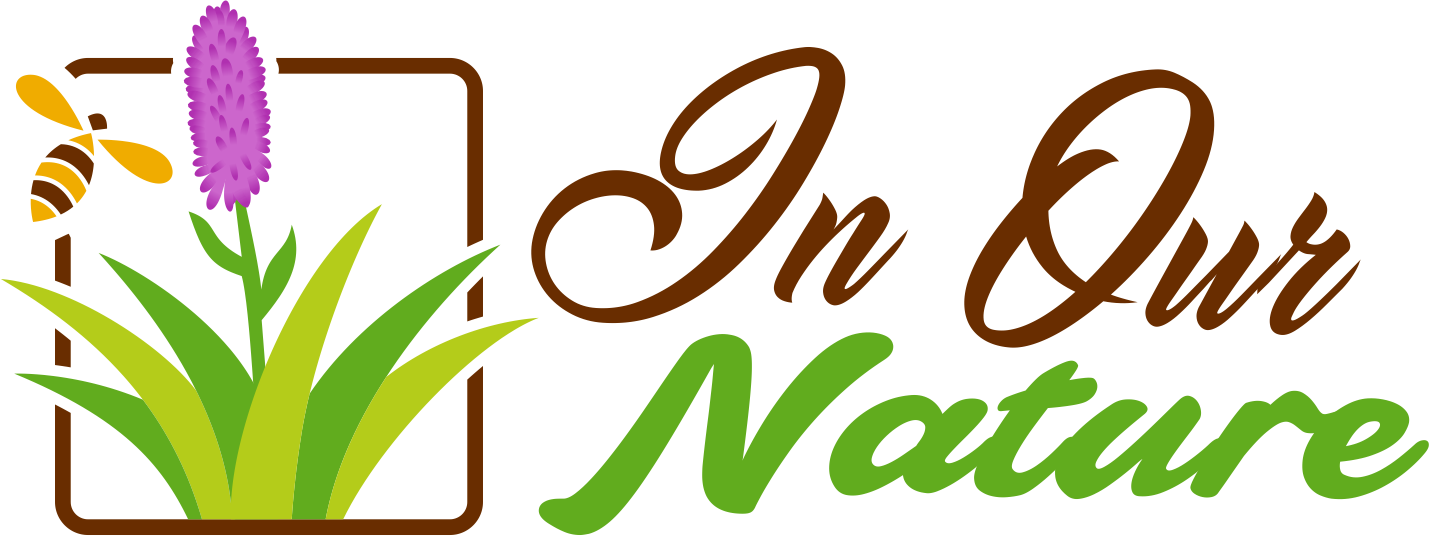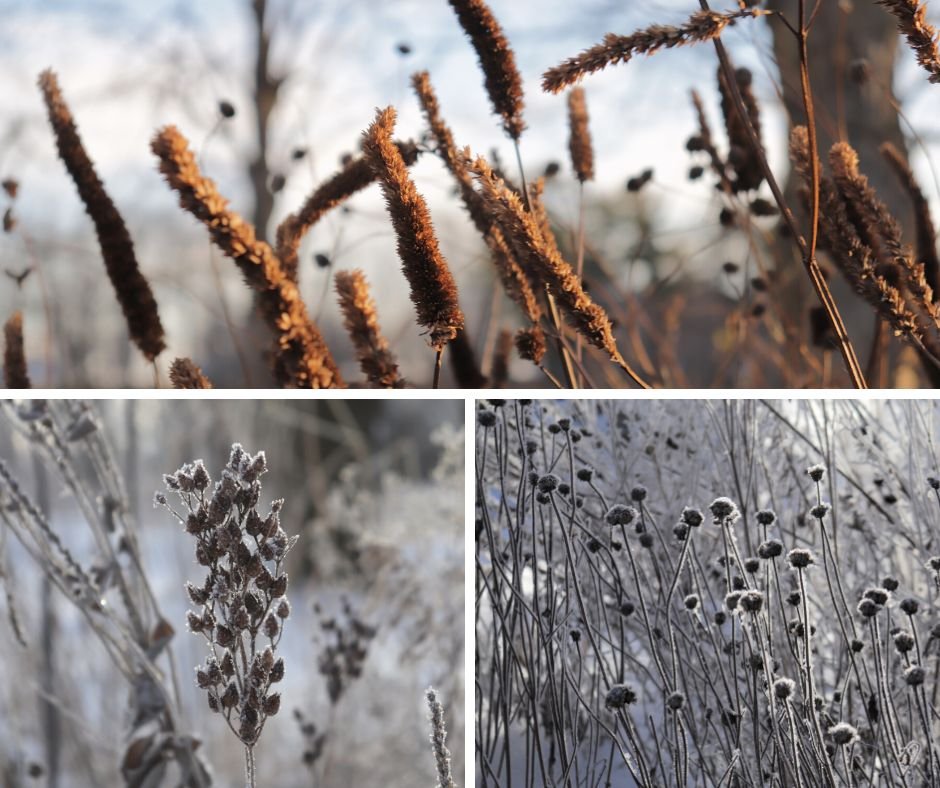Designing A Garden For
Winter Interest
| Top 5 tips to create stunning winter interest in your garden|
The ever-evolving colour palettes of spring, summer and fall blooms capture our interest while providing sustenance for both our souls and the wildlife we share our yards with.
Yet, all too often I see gardeners enthusiastically plan for these three seasons then, in anticipation for winter weather, proceed to cut their plants back once the last flower has faded.
When we leave our plants standing through all seasons, interest does not fade with the last flowers of the year, but rather, it transitions into the warm hues of fall then once again into more subtle earth tones of winter.
This transition of seasons is a natural process to be embraced in the garden because it provides us with dynamic landscapes where we can appreciate plants not only for their flowers, but for their structure, form, leaf colour and texture - the true essence of a winter garden.
NOTE: The first step to creating winter interest is to not cut back your garden, or at least wait until the spring. Here is why not cutting back your garden is good for wildlife.
1.Use Different Shapes And Sizes Of Seed Heads
The beauty of a flower doesn’t fade with the season, for seed heads are just a continuation of its beauty, but in a different form - the form of shapes and textures.
Think about the shapes and textures of each flower as it matures into a seed pod - every flower has a unique shape or texture to add to the garden in winter, so make sure to use plenty of variety.
Flower shape and size is important for pollinators too.
For the best winter interest in the natural garden, you will want to include a variety of flower shapes and sizes: spikey globes of purple coneflower; the candelabra like spires of culvers root; the jube-jube-like seedheads of wild bergamot or the pyramidal clusters of foxglove beardtongue.
I recommend pairing seed heads of contrasting shapes. For example, the combination of woodland sunflower and giant purple hyssop look great together because the small spheres of the sunflower contrast with the whimsical spires of the hyssop.
Generally, if you use a variety of different flower shapes and sizes then it will translate well into seed heads that work well together.
Seed head diversity in the winter garden!
2.Use Strong-Stemmed Plants
Winter winds can be tough on standing plant stems. Many plant stems give-way to the first snowfall, collapse and are never seen again until spring, such as those of pearly everlasting or golden alexanders.
So, be sure to include plants with strong stems that can take some of the abuse that winter throws at them.
Some stems will hold until mid-winter while some will persist until next spring.
Some top contenders that hold out until spring in my garden are the stems of giant purple hyssop, cup plant, woodland sunflower, culvers root, foxglove beardtongue, big bluestem, carpenters square and pale purple coneflower.
Standing plants not only increase winter interest, but will also create structure for over-wintering birds and will help collect snow to insulate your garden from harsh temperatures.
Your winter garden needs plants that can stand up to the weight of snow and ice as seen here.
3.Contrast Dark and Light Plants
Even once the last flower has faded for the season, colour never truly fades in a natural garden - it simply changes hues!
We have to learn to let go to the cheery yellows of summer and the vibrant purples of fall and welcome in a more subtle palette of brown, tan, bronze and cream created by dead standing stems and seed heads (you are leaving your stems standing through winter, right?).
Think brown is boring? Well, it doesn’t have to be if we use the concept of contrast in our winter gardens.
When working with a more subtle colour palette, you can make more dramatic of a statement by using a mixture of dark and light standing stems.
The simplest way to start experimenting with contrast is to pair grasses with perennials!
Think about it- most grasses fade to lighter hues of cream, tan, bronze and rust-brown (like the light tan/yellow of Switchgrass) while most perennials fade to darker colours like chocolate brown, dark bronze and some nearly black (like the beloved purple echinacea).
Pair them together and you have a lot more depth and interest for your yes to gaze upon.
Switchgrass & Purple Coneflower demonstrate how contrast can improve interest in your winter garden.
4.Grasses, Grasses, Grasses
Grasses are much under-used in most gardens! Yet, they are the unsung hero’s who provide 4-season support for the showy perennials who usually take front stage.
During the growing season, grasses fill in gaps between perennials with a neutral backdrop colour (greens) that help your showy flowers stand out.
Once the flowers fade for the season, the grasses once again help support the perennials by providing colour contrast to surrounding seed heads.
Grasses provide so much more colour diversity than just green. Include more grasses in your design to benefit from the rusted-tan of little bluestem, the bronze hues of prairie dropseed, the cream-beige of side-oats grama or the yellow-tinged palette of switchgrass.
Grasses also add garden interest in the form of motion. Imagine wide swaths of little bluestem swaying in the late autumn breeze as the late-afternoon sun lights up their fluffy seed heads with a golden glow - just stunning.
The top native grasses for winter interest:
The stunning colour palette of native grasses in the winter garden.
5.Shrubs With Persistent Seeds & Berries
Many shrubs will carry their fruits or seeds well into the winter months.
Use this to your advantage and not only provide survival food for birds, but give you something to enjoy from the comfort of a warm home.
Try using the following native shrubs for winter interest:
Winterberry (Ilex verticillata)
Snowberry (Symphoricarpos albus)
Highbush Cranberry (Viburnum trilobum)
Staghorn Sumac (Rhus typhina)
Fragrant Sumac (Rhus aromatica)
Juniper species (Juniperus spp.)
Spiraea alba (White meadowsweet)
Ninebark (Physocarpus opulifolius)
Buttonbush (Cephalanthus occidentalis)
Speckeled Alder (Alnus incana)
Shrubs with winter interest in the form of seeds or berries.







